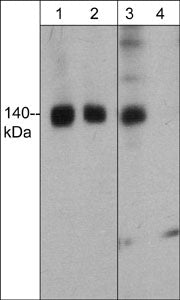Anti-FHOD1 (Thr-1141), Phosphospecific Antibody
- 产品详情
- 实验流程
- 背景知识
Application
| WB |
|---|---|
| Primary Accession | Q9Y613 |
| Host | Rabbit |
| Clonality | Rabbit Polyclonal |
| Isotype | IgG |
| Calculated MW | 126551 Da |
| Gene ID | 29109 |
|---|---|
| Other Names | FHOS, formin |
| Target/Specificity | Formins include several families of proteins that regulate actin cytoskeletal dynamics via two conserved formin homology domains, FH1 and FH2. The FH1 region contains poly-proline stretches that promote interactions with profilin. The FH2 domain, located C-terminally to the FH1 domain, is highly conserved in formin proteins and possesses actin nucleation and polymerization activities. Through cooperation of FH1 and FH2, formins construct actin-based structures comprising linear, unbranched filaments that are used in stress fibers, actin cables, microspikes, and contractile rings. Several mammalian formins, including mDia1, FRL, and formin homology domain protein 1 (FHOD1) are inhibited through an intramolecular interaction between the C-terminal Dia autoregulatory domain (DAD) and its recognition region at the N-terminus. In FHOD1, this autoinhibitory interaction is disrupted through phosphorylation of Ser-1131, Ser-1137, and Thr-1141 by ROCK. Subsequent FHOD1 activation leads to stress fiber formation. In endothelial cells, thrombin activates this ROCK pathway, leading to FHOD1-mediated stress fiber formation. |
| Dilution | WB~~1:1000 |
| Storage | Maintain refrigerated at 2-8°C for up to 6 months. For long term storage store at -20°C in small aliquots to prevent freeze-thaw cycles. |
| Precautions | Anti-FHOD1 (Thr-1141), Phosphospecific Antibody is for research use only and not for use in diagnostic or therapeutic procedures. |
| Shipping | Blue Ice |
For Research Use Only. Not For Use In Diagnostic Procedures.
Provided below are standard protocols that you may find useful for product applications.
BACKGROUND
Formins include several families of proteins that regulate actin cytoskeletal dynamics via two conserved formin homology domains, FH1 and FH2. The FH1 region contains poly-proline stretches that promote interactions with profilin. The FH2 domain, located C-terminally to the FH1 domain, is highly conserved in formin proteins and possesses actin nucleation and polymerization activities. Through cooperation of FH1 and FH2, formins construct actin-based structures comprising linear, unbranched filaments that are used in stress fibers, actin cables, microspikes, and contractile rings. Several mammalian formins, including mDia1, FRL, and formin homology domain protein 1 (FHOD1) are inhibited through an intramolecular interaction between the C-terminal Dia autoregulatory domain (DAD) and its recognition region at the N-terminus. In FHOD1, this autoinhibitory interaction is disrupted through phosphorylation of Ser-1131, Ser-1137, and Thr-1141 by ROCK. Subsequent FHOD1 activation leads to stress fiber formation. In endothelial cells, thrombin activates this ROCK pathway, leading to FHOD1-mediated stress fiber formation.
终于等到您。ABCEPTA(百远生物)抗体产品。
点击下方“我要评价 ”按钮提交您的反馈信息,您的反馈和评价是我们最宝贵的财富之一,
我们将在1-3个工作日内处理您的反馈信息。
如有疑问,联系:0512-88856768 tech-china@abcepta.com.























 癌症的基本特征包括细胞增殖、血管生成、迁移、凋亡逃避机制和细胞永生等。找到癌症发生过程中这些通路的关键标记物和对应的抗体用于检测至关重要。
癌症的基本特征包括细胞增殖、血管生成、迁移、凋亡逃避机制和细胞永生等。找到癌症发生过程中这些通路的关键标记物和对应的抗体用于检测至关重要。 为您推荐一个泛素化位点预测神器——泛素化分析工具,可以为您的蛋白的泛素化位点作出预测和评分。
为您推荐一个泛素化位点预测神器——泛素化分析工具,可以为您的蛋白的泛素化位点作出预测和评分。 细胞自噬受体图形绘图工具为你的蛋白的细胞受体结合位点作出预测和评分,识别结合到自噬通路中的蛋白是非常重要的,便于让我们理解自噬在正常生理、病理过程中的作用,如发育、细胞分化、神经退化性疾病、压力条件下、感染和癌症。
细胞自噬受体图形绘图工具为你的蛋白的细胞受体结合位点作出预测和评分,识别结合到自噬通路中的蛋白是非常重要的,便于让我们理解自噬在正常生理、病理过程中的作用,如发育、细胞分化、神经退化性疾病、压力条件下、感染和癌症。






